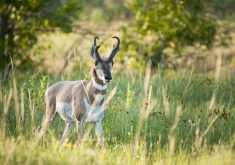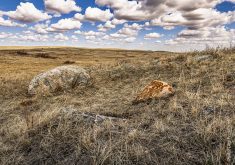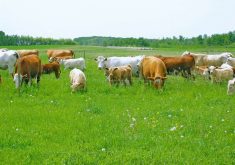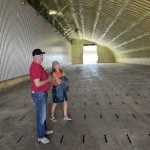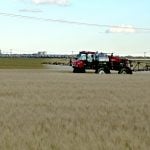The following is the final in a three-part series exploring how community pastures shifted from government to producer operation. You can read Part 1 here and Part 2 here.
The Prairie Farm Rehabilitation Administration’s (PFRA) community pasture program began in the 1930s as a quest to stop drifting soil and provide stable grazing for the region’s remaining farmers. The pastures dotted the Saskatchewan and Manitoba landscape, amounting to 2.27 million acres in the federal pasture program and another 780,000 acres in Saskatchewan’s provincial community pasture system.
Read Also

Canadian Beef Check-Off Agency reports on investments and activities
The check-off agency’s work behind the scenes is what ensures cattle check-off dollars are invested wisely, accounted for transparently and deliver measurable value back to producers and importers.
In 2012, the federal government announced they would transition community pastures over five years to producer groups that had existing allocations. A few years later, Saskatchewan made a similar announcement regarding provincially operated pastures.
Large-scale benefits endure
The pastures also became important sites for applied research for grazing systems, forage rejuvenation, and brush and weed management. Scientists and biologists used the living laboratories to monitor wildlife populations, study ecosystem dynamics, and learn about rare plants and sensitive landscapes.
Competing land interests from development, drainage and the energy and annual cropping sectors have left Saskatchewan with little more than 13 per cent of its native Prairie habitat remaining, notes Katie Doke Sawatzky at PrairieCommons.ca. Manitoba’s mixed grasslands and natural sandhills complexes share comparable statistics. Manitoba’s original tall grass prairie ecosystem has dwindled to less than one per cent, notes ManitobaGrass.ca.
In Saskatchewan, respective patron groups organized themselves to lease former community pastures from the government. The Ministry of Agriculture has a “no break, no drain” clause on land they deem ecologically sensitive, meaning pasture corporations face stiff fines if any ditching or cultivation happens.
In Manitoba, patrons opted to form an umbrella group, the Association of Manitoba Community Pastures (AMCP). Most former PFRA pastures signed on.
Conservation was the cornerstone for negotiating a lease agreement between AMCP and the Manitoba government. “We have to keep managing the land as before, and we have a responsibility to maintain those same [ecological] benefits,” says Barry Ross, general manager of AMCP.
They work with a range management committee, which includes members from federal and provincial governments and conservation NGOs such as the Nature Conservancy of Canada (NCC) and the Manitoba Habitat Heritage Corporation (MHHC).
Partnering for thebig picture
NCC is known for purchasing land and signing conservation agreements, and Braun acknowledges that doesn’t suit everyone’s idea of how land should be managed. “There’s a perception that there’s some competition between conservation organizations and ranchers, so there’s a relationship that needs to be built,” he adds.
He explains that working with community pasture patron groups was an adjustment for the NGO, too. “It was a head shift for our organization to start saying that it doesn’t matter who does conservation or doesn’t. What does matter is how biodiversity is conserved.”
NCC developed a pilot project working with five former PFRA pastures across diverse eco-regions in Saskatchewan, including Foam Lake, Lone Tree, Elbow-Wilner, Excel-Key West and Wreford-Nokomis. They provide financial support, conduct range and wildlife surveys, and work with managers and patrons to generate grazing and invasive species management strategies.
“The plans we work on with pasture managers and boards are not obligatory,” Braun says. He adds that NCC understands they need to also balance livestock use, habitat and the intricacies of working with different producers on one piece of land.
“It’s been good and they don’t put any dramatic demands out there,” says Trevor Benson, a patron at Excel-Key West pasture. “They realize that you hope for high expectations but you can’t achieve them in some instances.”
Benson adds having that extra money for management has helped their patron group make decisions.
Benson says NCC surveys have shown the pasture is home to rare plants and species at risk. “With the alkali sloughs and water sources, there are piping plovers,” Benson notes, which is a species of shorebird currently listed as endangered in Canada.
NCC has partnered in Manitoba with AMCP as well, says Ross. “They’ve been working with us for the past four years,” Ross says. “They’ve been a big help.”
AMCP has other sustainability collaborations too, and recently announced a sizable funding agreement with the Manitoba Conservation Trust. They received a cash injection of $325,000 to help enhance Prairie habitat and biodiversity by improving rotational grazing, managing brush encroachment and increasing livestock distribution. AMCP says this funding will help pastures manage key environmental issues as well as complete range assessments on the Narcisse and Sylvan Dale pastures.
Swapping one federal outfit for another
These pastures, which border Montana, provide habitat for species at risk including Sprague’s pipit, swift fox, long-billed curlew, northern leopard frog, burrowing owl, ferruginous hawk and more.
Bryan Tully is one of two former PFRA pasture managers that now works for ECCC. “We are doing grazing plans, range health assessments through the growing season and songbird monitoring,” says Tully. They are also establishing a biological baseline to use for future comparisons.
“We’re hoping that down the road, it’s an easy link between the number of songbirds and different kinds and what there is for grass and habitat,” Tully adds. They use a combination of fieldwork, trail cameras, autonomous recording units and other monitoring methods to survey.
Going from range rider to becoming a boots-on-the-ground naturalist for ECCC was a transition itself. “The biggest struggle was getting our heads around the computer side of things and the way this outfit communicates,” says Tully.
Tully and his counterpart are also responsible for capital expenditures, budgets, and working with the patron groups and managers who now operate the three pastures. “We are working with the shareholders to come up with grazing plans,” Tully says, adding they get input from patrons based on logistics and what their goals are.
Tully works with many of the same ranchers that he did when he was a pasture manager. He says building trust and maintaining transparency with the patron groups is important to him and ECCC.
“It’s eyes-wide-open moving into the future. There are no secrets over the fence and nothing to hide. We want to work with everyone who wants to work with us,” Tully says.
Industry wants a piece of the pasture
“I’m not against oil,” says Dallen Hamilton, pasture board member at Monet Community Pasture. “I enjoy talking on my cell phone and driving my truck, and putting tires on it,” he says, but adds there are likely better ways to access oil on these vast, native grasslands.
Luke Ellingson, Monet pasture manager, agrees. He says the oil field activity puts a lot of weight on patron groups and takes away from his regular workload. “The pasture isn’t necessarily getting the value out of the work we’re putting into it,” Ellingson says.
He estimates he spends up to three weeks each year fixing site fences, cleaning up garbage and ensuring that companies are doing what they are supposed to be doing, including sticking to access. “The pasture doesn’t get reimbursed for that time.”
Fortunately, Hamilton says their pasture manager is skilled at dealing with industry. “Luke is very good. He knows who he can call and [the board] supports whatever he decides 100 per cent,” says Hamilton. “But it’s just one more thing, right?”
ECCC is currently working through the responsibility of removing some oil and gas infrastructure on their three large pastures. “Natural gas is a big thing on my plate right now,” says Tully. “Everything is being shut in, equipment removed, and reclamation on pretty much all the wells,” he says.
It’s a long-term process that isn’t perfect, he adds, and a site may look clean, but still have contaminated soil or other issues left behind, complicating Prairie restoration.
Staying the course
He adds that good managers are there doing good management, and he appreciates that pasture management work is a family affair.
Governments, NGOs and patron groups all say that grazing is fundamental to maintaining habitat, biodiversity and other environmental benefits of pasture land.
“You know that was one of the most important things to persuade me to take this on,” on working for ECCC, says Tully. “I didn’t feel like I was done on those pastures. It was a great opportunity to stay on and still see them as a working landscape.”
“Down the road, the grazing is going to lead us to achieve our goals.”
Tara Mulhern Davidson is a writer and beef and forage consultant. She ranches with her family in southwestern Saskatchewan. She’s also a former PFRA range specialist as well as a patron in community pastures, which are not profiled in this series.



